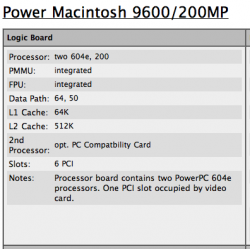For us in this business, a dual processor machine has 2 processor chips in independent sockets, no matter that those sockets are mounted on a single daughtercard (like the G4 duals) or separately, directly in their own sockets on the motherboard.
A dual core is two CPU units on a single silicon processor chip, which may or may not share some circuitry. But they are packaged into the same package with one set of pins.
Yes, but both examples have two cores, and both examples have two processors. You didn't prove or disprove anything.
A daughter card with 2 processor sockets mounted on it does not make it a dual-core.
Well... it has two processors, and it has two cores. So why not?
All Dual-core machines are by definition dual-processor
Yes!!! Exactly!
but we use Dual-Processor to designate 2 CPUs in 2 different sockets. This is an identifying feature of the machine, such as differentiating between G5 towers of the same speed.
But why? I'm aware of what the phrases "dual core" and "dual processor" are accepted today as meaning. I'm calling that acceptance (or non-acceptance) into question. If I say my Mac Pro has four processors - I am
not wrong.
Lets start from the beginning. One processor is a one processor system. Now add an entirely new processor to the system and you have a dual processor system. Now combine those two processors onto the same chip and you have a dual core system. I believe we are all agreed on this.
No, we didn't. Are you suggesting that your first example doesn't have a single core, your second example doesn't have two cores, and your third example doesn't have two processors?
Now calling a dual core system the same as the dual processor system is not the same. As the dual core system shares the same system bus to access RAM and other important parts of the system. This slows it down as it has the same amount of throughput as the dual processor system yet half the available bandwidth.
That's the worst definition of dual core I've ever heard, as plenty of examples of that exact setup have already been given (dual G4s, dual 9500s, dual 9600s). Those were all called dual processor systems. Independent cache, buses, access to ram and the system are
not part of the definition of a processor.
Now I guess you could call a dual core system a dual processor system but that would be implying a system without that limit in place and thus giving the wrong impression.
The wrong impression to people who have bought into the false idea that the definition of a processor includes all those things.
The important thing to note in this dicussion is not the fact there there are two processors as this has already been agreed to be the case. The important thing to note is the differences between the two whether these differences mean that a new name should be used to differentiate between the two.
Regardless of whether or not you give this combination a new name, somebody saying a Mac Pro has four processors is not wrong.
They are not wrong. You can not say they are.
In this case the difference in available bandwidth to the two cores limits them and so they do not perform to the same level as two entirely separate processors. While this maybe a small difference in most real world applications the fact that they can not perform to the same level as two separate processors is what derives the need for a different name to distinguish the two.
I already addressed all this several times. "Naming" the combination of two processors in this manner is perfectly fine (although, it is by no means a new thing). The problem is the name is totally wrong. You do not nail two pieces of wood together at a right angle, call it "a right angle" and then insist they are no longer two pieces of wood, nor insist that two pieces of metal combined in a similar shape are "not a right angle."
Maybe that has helped clear up my position?
Yes. I am aware of what you think.


